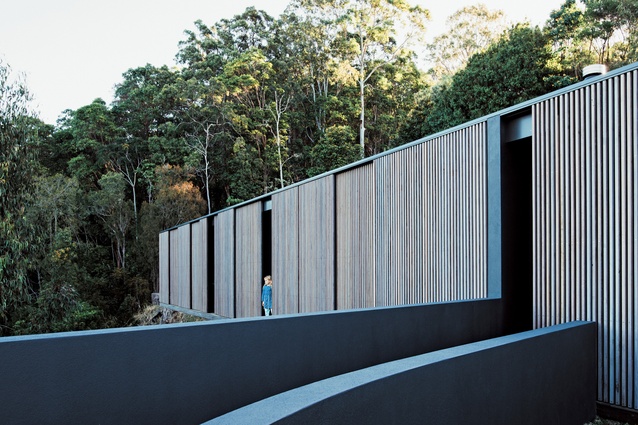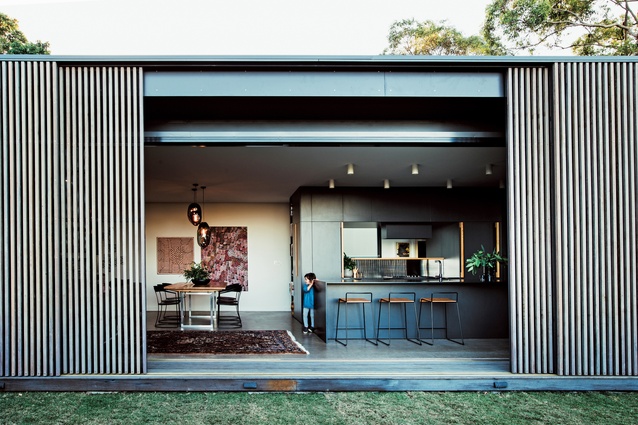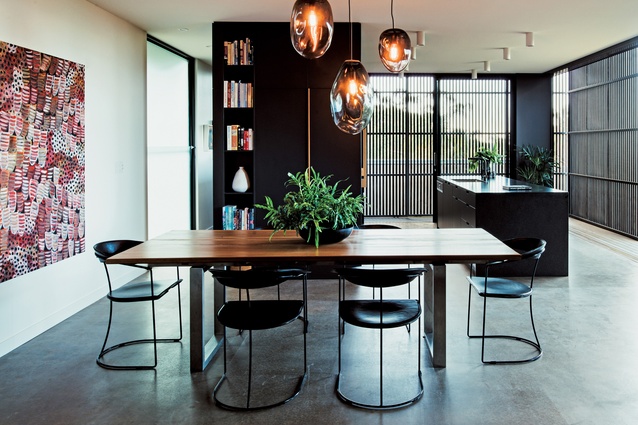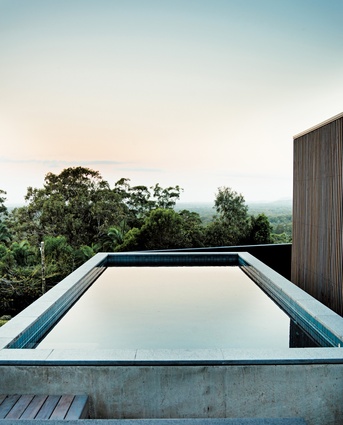‘An elemental shrine’: Tinbeerwah House
Resting on a steeply sloping, heavily damaged site, this house by Teeland Architects works to stabilise and rehabilitate the land while offering expansive views of the forest beyond.
In one translation from the Gubbi Gubbi language of the local Aboriginal people, the placename “Tinbeerwah” means “land of grass trees.” In another, it is said to mean “high hill.” Either works for Tinbeerwah House, which sits on a splendidly elevated platform in the bushy hinterland of Noosa, on Queensland’s Sunshine Coast.
When the current owners bought the 8,745-square- metre property in a semirural enclave of tree changers, they inherited from the previous owners the results of a decade of site clearing. A denuded building platform had been established, with a studio/office pavilion below. Much necessary intervention in stabilization, retention and drainage followed, but the rewards of the location are eminent.
Teeland Architects was commissioned to design a home for the young family of five that was robust and practical while celebrating the pleasures of the location. The building platform presented a gift amid the somewhat bald narrative of the confronting moonscape, which principal David Teeland refers to as “an open-cut mine” of sorts.

The adjacent patch of sloping land to its south is a richly diverse forest of eucalyptus, awash with birdlife and wallabies. A sweeping view east and north takes in a long stretch of coastline and the Pacific Ocean in the distance, with a broad swathe of forest intervening. The elevation disguises the existence of small properties, creeks and hamlets between the house site and the ocean some fifteen kilometres away, as the eye sweeps over the treetops and their thick, obscuring foliage.
The temptation to design a home that juts outward and upward would have lured some wanting to grab maximum views, but David opted for a more discreet and recessive approach. “It was important to keep the home close to the ground, so that the young children can easily step out onto the earth,” he says.
The essential grounding of the house in the landscape is also a paean to the majesty of what lies beyond – the bush, the ocean, the stars and sky – and this simple, almost monastic box establishes an elemental shrine for observing these, rather than an overpowering monument.
From the street entry point, the house is indeed invisible, tucked in above and behind the curving rampart of the driveway and courtyard walls. A narrow chasm-like path and staircase slices through the curves, gradually revealing more of the piece. But it is not until arrival at the front door that the facade is fully legible.

The long rectangular pavilion touches the earth at its northern end and hovers a metre or so above it at the south. It is wrapped in a carapace of sliding battened timber screens, rendering degrees of light, privacy and outlook subject to the whims of the inhabitants. Comparisons with a Japanese tea house or temple pavilion spring to mind.
Like these buildings, the palette here is organic and the craftsmanship apparent. The outlook from each room along the long skinny space also has its own point of difference, and direct connection to the garden. The spotted gum battens are fast silvering in deference to sun and wind, another similarity to the Japanese reverence for organic decay.
The rectilinear plan is one room deep, maximizing cross-ventilation. The mobile screens provide protection from the sun in summer, and allow lower winter sun to creep in and warm the concrete floors. Kitchen and living spaces are at the northern end, spilling onto a walled garden to the east and a raised swimming pool to the north.
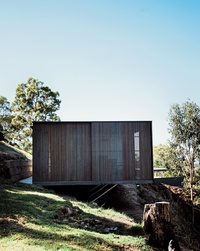
Bedrooms take up the remainder of the length, accessed by a rear corridor/breezeway with double-hung windows punctuating its length. The main bedroom is set into a glazed corner that contemplates the bushland, with a private deck running along its perimeter. Further privacy between the four bedrooms is established with two back-to-back bathrooms dividing the parents’ zone from the children’s bedrooms.
The north–south corridor terminates at each end with a view outside to bush and sky through floor-to-ceiling double-hung windows, so that the powerful spatial experience isn’t all given over to the eastern outlook. The long corridor is a harbour for much built-in storage. A laundry sits opposite the access door to the western exterior service corridor, where the clothesline and pool machinery have a place.
The interstitial deck between the sliding timber screens and the operable glass skin of the inner box forms another layer of individual territory claiming outside each bedroom or, in the case of the living areas, a shared community space. This flexibility of space – of mysteriously un-designated use and open claiming rights – renders the efficient 200-plus-square-metre plan more expansive.
The owners work from the existing studio below the carport, taking the journey up to the kitchen during the course of the day for coffee breaks and meals. The ritual of exiting their office, observing the bush, then winding up and around the paths to the house has been consciously orchestrated by David as a pleasurable one that delights in the capturing of the calm quietude of these elemental spaces.
This article was first published on architectureau.com

